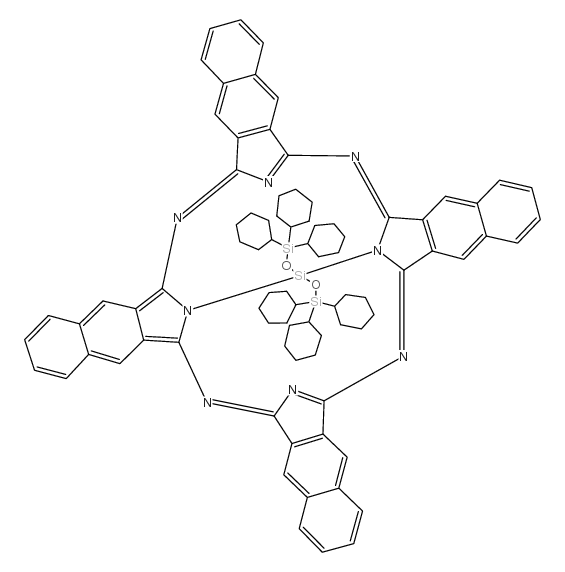bis(trihexylsiloxy)silicon 2,3-naph- thalocyanine

bis(trihexylsiloxy)silicon 2,3-naph- thalocyanine structure
|
Common Name | bis(trihexylsiloxy)silicon 2,3-naph- thalocyanine | ||
|---|---|---|---|---|
| CAS Number | 92396-88-8 | Molecular Weight | 1327.92000 | |
| Density | N/A | Boiling Point | N/A | |
| Molecular Formula | C84H90N8O2Si3 | Melting Point | 270ºC (dec.)(lit.) | |
| MSDS | Chinese USA | Flash Point | N/A | |
| Name | bis(trihexylsiloxy)silicon 2,3-naph- thalocyanine |
|---|
| Melting Point | 270ºC (dec.)(lit.) |
|---|---|
| Molecular Formula | C84H90N8O2Si3 |
| Molecular Weight | 1327.92000 |
| Exact Mass | 1326.65000 |
| PSA | 102.48000 |
| LogP | 18.52780 |
| Personal Protective Equipment | Eyeshields;Gloves;type N95 (US);type P1 (EN143) respirator filter |
|---|---|
| Safety Phrases | S22-S24/25 |
| RIDADR | NONH for all modes of transport |
|
Phthalocyanine photodynamic therapy: disparate effects of pharmacologic inhibitors on cutaneous photosensitivity and on tumor regression.
Photochem. Photobiol. 65(5) , 895-901, (1997) The phthalocyanines are promising second-generation photosensitizers that are being evaluated for the photodynamic therapy (PDT) of malignant tumors. In vivo studies with the silicon phthalocyanine Pc... |
|
|
Plasma pharmacokinetics and tissue distribution in CD2F1 mice of Pc4 (NSC 676418), a silicone phthalocyanine photodynamic sensitizing agent.
Cancer Chemother. Pharmacol. 44(4) , 283-94, (1999) Pc4 is a silicone phthalocyanine photosensitizing agent that is entering clinical trials. Studies were undertaken in mice to develop a suitable formulation and analytical methodology for use in pharma... |
|
|
Silicon phthalocyanine Pc 4 and red light causes apoptosis in HIV-infected cells.
Photochem. Photobiol. 65(3) , 456-60, (1997) The silicon phthalocyanine HOSiPcOSi(CH3)2(CH2)3 N(CH3)2 (Pc 4), is being studied as a photosensitizer for virus inactivation in red blood cell concentrates (RBCC). The RBCC spiked with cell-free huma... |